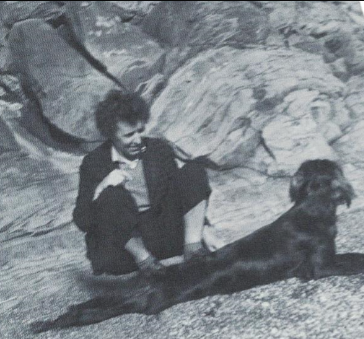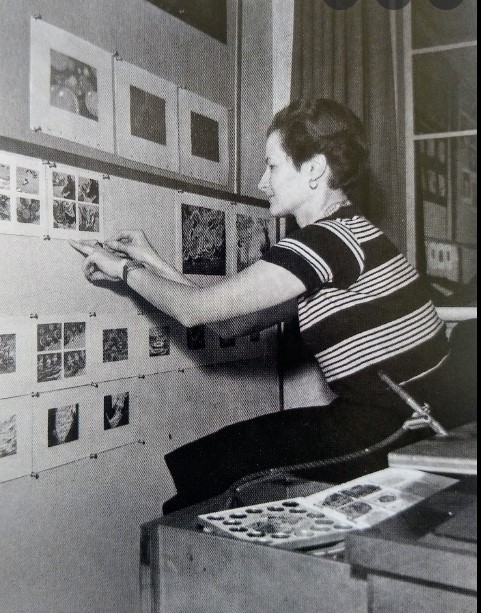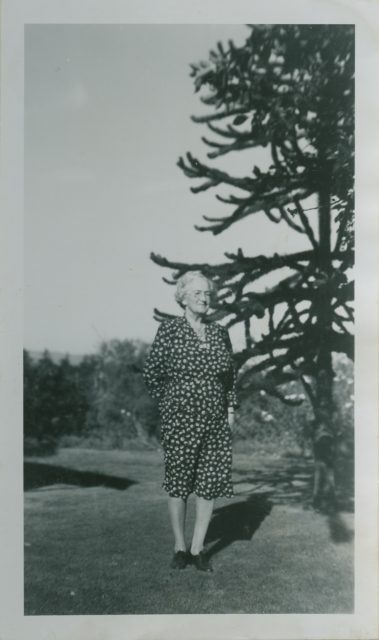Five amazing women who put their stamp on BC in unique ways. There is more information about them in At Home with History, Sensational Victoria and Sensational Vancouver, and in the books listed below.
Capi Blanchet (1891–1961)
Capi Blanchet was found dead in 1961, slumped over her typewriter while writing a sequel to The Curve of Time. For a writer, that’s not a bad way to go. The tragedy in Capi’s case is that she died without ever having an inkling of the success her book would enjoy. There was no way for her to know that a half century into the future, her book would be republished in a 50th-anniversary edition and be a regional best-seller.

Born in Montreal, Muriel Liffiton married Geoffrey Blanchet, a banker when she was 18. In 1922 the family drove out west and bought Clovelly, a house designed by Samuel Maclure near Sidney. Soon after moving in, the Blanchets bought a boat called the Caprice. In 1927 Geoffrey took the boat out and never returned. That left 33-year-old Capi to raise five kids aged between two and 14, and to wonder if it was accident or suicide.
The resourceful Capi rented out her house, packed up her kids and Irish setter, and set off for what would be the family’s annual journey around British Columbia’s rugged coastline. The rent supplemented her income, and the trips provided the basis for her book.
Muriel “Capi” Wylie Blanchet (1891-1961)
Blanchet, M. Wylie. The Curve of Time (50th anniversary edition). Whitecap, 2011.
Gwen Cash (1891–1983)

When Gwen Cash went to work for Walter Nichol at the Vancouver Daily Province in 1917, she was one of the first women general reporters in the country. Gwen and her husband Bruce settled in Victoria in January 1935. She was the public relations officer for the Empress Hotel and wrote three books including her memoir, Off the Record. In 1954 she had John di Castri design a house to prove that small didn’t have to mean a box. Called the Trend House, it was one of 11 built in Canada and sponsored by BC forest industries to boost retail lumber, plywood, and shingle sales. At 835 sq.ft. Gwen’s house was the smallest, but also the most talked about. “Conventional Victorian viewers, addicted to pseudo-Tudor or modern box construction, were puzzled and vaguely angered by its unique design. Like modern painting it was something that they couldn’t understand,” she wrote. The house was opened to the public for three months and more than 34,000 people trekked through.
Cash, Gwen. Off the Record. Stagecoach, 1977.
Sylvia Holland (1900-1974)

Sylvia Holland met her Canadian husband at architectural school in London, England. They moved to Victoria in 1925 and designed their house. Two years later Frank was dead and Sylvia was left to raise two babies on the eve of the Depression. To make ends meet, Sylvia rented out her house and moved to Metchosin, where Frank’s parents had a farm. Even during those lean times, she managed two architectural commissions. When Boris was diagnosed with the same infection that had killed his father, Sylvia moved to Los Angeles and was hired by Universal Studios and then by MGM as a background artist. Walt Disney hired her as one of his first women animators, and she worked on productions such as Fantasia and Bambi. She worked for Disney for several years, bought an acre of land in the San Fernando Valley and designed a large two-storey house where she set about developing the Balinese breed of cat. She never married again. “All the single guys at Disney were courting her, but she chose to retain her independence,” says her daughter Theo. “She said, ‘If I had a man, what would I do with him?’”
Nellie McClung (1873-1951)

When Nellie retired to Gordon Head in 1935 and made sauerkraut and dill pickles from her garden, few neighbours realized how famous she was until her image came out on a 1974 postage stamp. Nellie fought for women’s rights and her accomplishments are long and awe inspiring. In 1900 a woman’s salary was legally the property of her husband. He had control of their children, and of her. The law defined an eligible voter as “a male person, including an Indian and excluding a person of Mongolian or Chinese race.” And, if that wasn’t clear enough; the Election Act went on to say: “No woman, idiot, lunatic or criminal shall vote.”
Nellie raised five kids in rural Manitoba. By 1908, she had written the first of 16 books. That novel, Sowing Seeds in Danny sold over 100,000 copies—outselling Lucy Maud Montgomery’s Anne of Green Gables, which came out the same year—in a country where 5,000 is still considered a best-seller.
In 1928, she was one of five women who went to the Supreme Court of Canada to insist women are “persons,” and eligible to be named to the Senate. She campaigned for the Liberals in 1935, was the first woman to sit on the CBC board of directors the following year, and in 1938, represented Canada in 1938 at the League of Nations in Geneva.
McClung, Nellie. The Complete Autobiography. Broadview Press, 2003.
Helen Gregory MacGill (1864-1947)
Helen was the first woman to graduate from Toronto’s University of Trinity College, and she was the first woman judge in B.C. From 1917 she presided over Vancouver’s Juvenile Court, fighting for the rights of women and children. Her husband was a sketchy lawyer and their finances went up and down with the times. The MacGill’s bought a house in Vancouver’s West End in 1908, and lost it five years later when they couldn’t afford the taxes.
By 1926 Helen’s judge’s salary had increased to $100 a month, she received $3,000 in damages from an accident settlement and they bought back the Harwood Street house. The house withstood the apartment blitz of the 1950s and is a strata conversion painted a regal red.
The MacGill’s younger daughter Elsie (1905-1980) became a trend setter like her Mum. She was the first woman to receive an electrical degree in Canada and the first woman aircraft designer in the world. She earned the name “Queen of the Hurricanes” for her work on the Hawker Hurricane fighters during the Second World War.
MacGill, Elsie Gregory. My Mother the Judge. Toronto: Ryerson Press, 1955.
For more stories like this one:
© All rights reserved. Unless otherwise indicated, all blog content copyright Eve Lazarus.




7 comments on “Five Amazing Women of BC”
Great stuff- love the personal spin on all of these amazing women. Keep it coming!
[…] Five Women of British Columbia — Every House Has a Story […]
Thank you for honoring my great grandmother. She was an amazing – and tough – woman who did more on her own during a time where women were often meek and subservient than many of us could fathom enduring now as ‘supermoms’ and modern women. You’ve put her in very good company here.
She deserved it! Amazing woman.
Fascinating women! Fascinating stories! Thanks for sharing!
Thank you so much for introducing these
“Five Amazing Women of BC!” I’m bringing their stories to light, you honour each of these very deserving, intelligent, interesting and creative women, who have used their lives to inspire and benefit ours!
In sharing their stories you prove that women are indeed just as smart, determined and capable women really are.
And like the saying goes,……”they did it all in a Dress and High Heels too!”
[…] the back cover of the book, there’s a photo of Nellie McClung standing in front of a giant monkey puzzle tree at the house she retired to at Gordon Head in […]